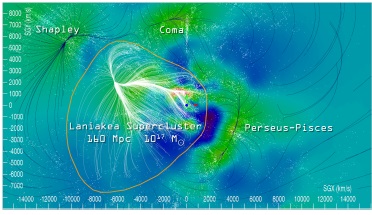The team proposes a new way to define and measure these massive structures by examining their effect on the speed of galaxies.

A team of astronomers and astrophysicists that includes Prof. Yehuda Hoffman from the Rakah Institute of Physics at the Hebrew University recently engaged in studying the history of the local supercluster of galaxies (including ours). In an article published this week in NATURE, the supercluster mapped by the team is described and named "Laniakea" (meaning in the native language of Hawaii: "huge paradise").
Galaxies are not randomly distributed throughout the universe, but accumulate in galaxy clusters. The local group we are in is a small cluster of two galaxies, the Milky Way and Andromeda. Galaxy clusters contain up to thousands of galaxies. The galaxy clusters themselves accumulate and form "superclusters". The distribution of galaxies in space simulates a kind of network of webs - which looks similar to a network of spider webs and the networks of neurons in the brain - which leaves huge spaces devoid of galaxies and converges to the large clusters of galaxies. Defining the size and scope of "superclusters" remains open and challenging.
The team proposes a new way to define and measure these massive structures by examining their effect on the speed of galaxies. A galaxy between two such structures will be caught in a gravitational battle between the superclusters surrounding it, which will determine its speed and direction of movement. With the help of mapping the velocities of galaxies in the universe near us, the team was able to define the region in space over which the gravity of each supercluster "dominates".
The team's work, which was based on a combination of new observations and the new calculation method, led to the identification and mapping of the "Laniakea" as the local supercluster on whose edge we reside. The diameter of Laniakea is about 500 million light-years and its mass is 10 times the mass of the Sun to the 17th power.
The team included Prof. Brent Tully from the University of Hawaii (USA), Prof. Helene Courtois and Dr. Daniel Pomared from France.

8 תגובות
It seems that the terminology is getting mixed up here.
If the galaxy is a grape,
So a cluster of galaxies can be called a cluster.
And a cluster of clusters can be called: a tree.
And a cluster of trees can be called: a vineyard.
And a cluster of vineyards can be called: a valley.
(What has been discovered is a tree to which the Milky Way belongs.)
And maybe it's better to call them:
A galaxy is a cluster of degree 0.
A cluster of galaxies is a cluster of degree 1. (A cluster of degrees zero)
And so on.
What I want to say: you must use unambiguous symbols. "Super cluster" is just an inappropriate word.
It reminds me of the football association. Instead of naming the leagues "first, second, third league..." They gave them ambiguous names such as "National League", "Super League" (wrong Hebrew), "National League". And we got a salad of leagues that only an Israeli football fan knows the ins and outs of. By the way, pay attention to the simplicity of the names of the English...
Does anyone know if we know about the mechanics of the cluster, i.e. does it revolve around a common object or center?
"A supercluster has been discovered" is not the same thing as a "supercluster has been mapped"
Sorry - somehow the SUPERSCRIPT commands were deleted.
The mass of the cluster is 10 to the power of 17 solar masses. You need to learn to write it in HTML like this:
1017
I tried to write but the problem is that in Hebrew the order is reversed. Where is the programmer who will solve the problem?
At the end of the news it is written that the mass of the cluster is 1,017 times the mass of the Sun. If the mass of one galaxy is several million times (at least) the mass of the sun, since there are at least several million stars there - how is it possible that an entire cluster is only 1,017 times?